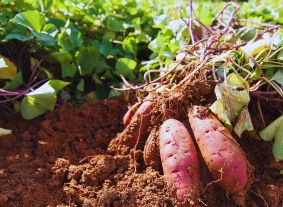Container Victory Garden Considerations
Views: 7676

In my two editions of Just Veggies I riffed off the Victory Garden 2.0 blogs posts released by the National Garden Bureau in response to the coronavirus pandemic. My first post was about planning a modern victory garden and the second was about planting your Victory garden with vegetables. This week’s post is in response to NGB’s 10 tips for planting your Victory Garden in containers. Don’t have outdoor in-ground garden space? Not a problem! We’ll help you get some fresh edibles out of a container in no time.
As in previous blog posts, I’ll share a few of NGB’s tips along with my own spin on or experiences with them.
Use Big Containers
Just like in an in-ground garden, we often think we can squeeze a whole lot more plants into a space, forgetting or not realizing how big the plants eventually grow. When in doubt, think bigger is better for your container victory garden. Yes, bigger pots means more soil and also might prohibit you from moving the pots easily. But, the bigger (especially deeper) the pot, the more roots can grow and the more water you can add to the container. Both factors will help the plants grow strong and survive drought conditions (or maybe you forget to water one day?). As for heavy pots—try placing pots on roller trays!
Think About Container Placement
If your pots are on a building balcony, you’ll have to consider two things: 1) Will your pots be shaded by other buildings or structures as the day progresses? 2) How breezy is it on your balcony or roof deck? It’s often way more windy high above ground. Wind can damage leaves by whipping them around, especially broad-leaved plants like zucchini. NGB suggests grouping many smaller pots together so as to create a wind block of sorts. Your container victory garden will appreciate just a small breeze, not a gale storm!
Consider Drip Irrigation
Remember what I said above about small pots needing more frequent watering (or bigger pots holding more water). During very warm days you might find your vegetable pots need to be watered every day—or even twice a day! Don’t let your plants experience frequent water stress—it weakens their ability to fight off disease and insects. Drip irrigation systems are easy to set up, and there are a bunch of different systems out there. Most are customizable and can be arranged to fit your own particular container arrangements.
Don’t Forget Pollinator Plants!
Many vegetables need pollinators in order to produce a crop. If your container victory garden is in a spot where pollinating insects aren’t normally found—like up on a roof or balcony—lure them in with some colorful flowers. Sometimes it’s hard for pollinating insects to find the somewhat smaller and less showy flowers of a vegetable plant. Plant something like a sunflower, nasturtiums or marigolds to shout, “Hey you bees, I’ve got nectar over here for you!” And it turns out all three of those flowers I mentioned are either edible or act as pest control.
Meet Ellen Wells
When you’re raised on a farm, you can’t help but know a thing or two about gardening. Ellen Wells is our expert on edible gardening.…







